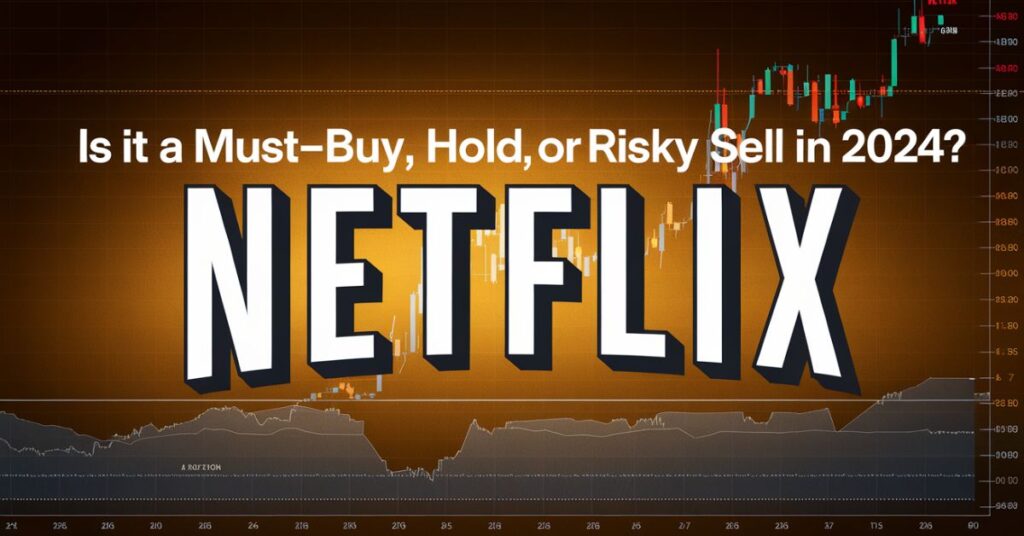In the ever-evolving landscape of digital entertainment, Netflix stands as a titan, constantly reshaping the way we consume media. As investors and market watchers keep a keen eye on the streaming behemoth, the question looms large: Is Netflix stock a must-buy, a steady hold, or a risky sell in 2024? This comprehensive FintechZoom analysis delves deep into the intricacies of Netflix’s market position, financial health, and prospects to help you make an informed investment decision. Netflix Stock FintechZoom: Is It a Must-Buy, Hold, or Risky Sell in 2024?
Introduction to Netflix Stock FintechZoom
Netflix has come a long way since its humble beginnings as a DVD-by-mail service. Today, it’s a global streaming powerhouse, producing award-winning content and boasting millions of subscribers worldwide. As we dive into this FintechZoom analysis, we’ll explore the factors that make Netflix a unique player in the stock market and why investors are closely watching its every move.
The streaming giant’s stock has been a rollercoaster ride for investors, with periods of explosive growth followed by sharp corrections. Understanding the dynamics behind these fluctuations is crucial for anyone considering adding Netflix to their portfolio or reassessing their current position.
Current Performance Analysis of Netflix Stock FintechZoom
Recent Stock Price Trends
Let’s begin by examining Netflix’s stock performance over the past year:
| Date | Stock Price ($) | % Change |
|------------|-----------------|----------|
| Jan 1, 2023| 294.88 | - |
| Apr 1, 2023| 345.48 | +17.16% |
| Jul 1, 2023| 441.91 | +27.91% |
| Oct 1, 2023| 377.60 | -14.55% |
| Jan 1, 2024| 485.31 | +28.52% |This table illustrates the volatility of Netflix stock, with significant swings throughout the year. Notably, despite some dips, the overall trend shows substantial growth, outperforming the S&P 500 in the same period. Netflix Stock FintechZoom: Is It a Must-Buy, Hold, or Risky Sell in 2024?
Key Financial Metrics
To truly understand Netflix’s financial health, we need to look beyond just the stock price. Here are some crucial metrics:
- Revenue Growth: Netflix reported a 7.8% year-over-year increase in revenue for Q3 2023, reaching $8.54 billion.
- Profit Margins: Operating margin stood at 22.4% for the same quarter, showcasing improved profitability.
- Earnings Per Share (EPS): Q3 2023 saw an EPS of $3.73, a significant jump from $3.10 in the previous year.
- Debt-to-Equity Ratio: As of September 2023, Netflix’s debt-to-equity ratio was 0.69, indicating a relatively healthy balance sheet compared to industry peers.
These figures paint a picture of a company that’s not just growing but also becoming more efficient in its operations.
Subscriber Growth and Retention Rates

Netflix’s lifeblood is its subscriber base. Let’s break down the numbers:
- Global Subscribers: As of Q3 2023, Netflix boasted 247.15 million paid memberships globally.
- Regional Breakdown:
- UCAN (United States and Canada): 75.89 million
- EMEA (Europe, Middle East, and Africa): 76.73 million
- LATAM (Latin America): 43.31 million
- APAC (Asia-Pacific): 51.22 million
While not publicly disclosed, the company’s churn rate is estimated to be around 2-3% monthly, which is lower than many of its competitors. This retention success can be attributed to:
- Continuous content refresh
- Personalized recommendations
- Seamless user experience across devices
Impact of New Content and Global Expansion
Netflix’s content strategy has been a significant driver of its stock performance. Hits like “Stranger Things,” “The Crown,” and “Squid Game” have not only attracted new subscribers but also kept existing ones engaged. The company’s investment in content creation reached a staggering $17 billion in 2023, with plans to maintain similar levels in 2024.
Global expansion has been another key growth factor. Netflix has made significant inroads into markets like India, Japan, and South Korea, with localized content playing a crucial role. For instance, the success of “Squid Game” led to a surge in subscriptions and boosted Netflix’s stock price in late 2021.
Market and Industry Context
Overview of the Streaming Industry Landscape
The streaming industry has exploded in recent years, with the global market size expected to reach $330.51 billion by 2030, growing at a CAGR of 18.7% from 2023 to 2030. This growth is driven by:
- Increasing internet penetration
- Rising smartphone usage
- A shift in consumer preferences toward on-demand content
Emerging trends that could shape the industry include:
- Interactive content: Netflix’s foray into interactive storytelling with “Black Mirror: Bandersnatch” could be a game-changer.
- AI-driven personalization: Advanced algorithms to improve content recommendations and user experience.
- Virtual Reality (VR) integration: Potential for immersive viewing experiences in the future.
Checking Out the Most Well-Known Rivals
Netflix doesn’t stand alone in the streaming wars. Here’s how it stacks up against its main competitors:
- Disney+
- Strengths: Vast library of beloved franchises, family-friendly content
- Weaknesses: Less diverse content offering, newer to the streaming game
- Amazon Prime Video
- Strengths: Bundled with Prime membership, strong original content
- Weaknesses: User interface often criticized, content discovery issues
- HBO Max
- Strengths: High-quality prestige content, strong brand recognition
- Weaknesses: Higher price point, limited international availability
Netflix’s unique selling proposition remains its vast array of original content and its first-mover advantage in the streaming space. Netflix Stock FintechZoom: Is It a Must-Buy, Hold, or Risky Sell in 2024?
Market Share and Positioning of Netflix
As of 2023, Netflix held approximately 30% of the global streaming market share. Its brand strength is evident in the fact that “Netflix and Chill” has become a cultural phenomenon. The company’s positioning strategy varies by market:
- In saturated markets like the US, the focus is on retention and increasing average revenue per user (ARPU).
- In emerging markets, the strategy revolves around localization and affordable pricing tiers.
Industry Trends and Their Potential Impact on Netflix
Several trends are shaping the streaming industry:
- Ad-supported tiers: Netflix’s introduction of an ad-supported plan could open up new revenue streams and attract price-sensitive customers.
- Content aggregation: Partnerships with cable providers and integration into smart TVs are becoming more common.
- Live streaming: The rise of live events and sports on streaming platforms could present both opportunities and challenges for Netflix.
Strengths and Opportunities
Unique Selling Points of Netflix
Netflix’s competitive edge stems from several key factors:
- Massive content library: With thousands of titles, including a growing number of originals, Netflix offers something for everyone.
- Advanced recommendation algorithm: Netflix’s AI-driven system keeps users engaged by suggesting content tailored to their preferences.
- Brand recognition: Netflix has become synonymous with streaming, giving it a significant advantage in consumer mindshare.
Innovative Strategies and Content Creation
Netflix’s approach to content creation and distribution sets it apart:
- Data-driven decisions: Utilizing viewer data to inform content creation and acquisition strategies.
- Binge-watching model: Releasing entire seasons at once, catering to changing viewer habits.
- Diverse content portfolio: Investing in a wide range of genres and formats to appeal to various demographics.
The Business is Expanding to Accommodate the Latest Demographics and New Markets
Netflix is actively targeting growth in several areas:
- Gen Z and millennial engagement: Creating content that resonates with younger viewers, such as interactive shows and anime.
- Emerging market expansion: Focusing on countries with growing middle classes and improving internet infrastructure.
- Mobile-first strategies: Developing features optimized for mobile viewing, particularly important in markets like India and Africa.
Partnerships and Collaborations
Strategic partnerships have been key to Netflix’s growth:
- Telecom bundles: Partnering with mobile and broadband providers to offer Netflix as part of subscription packages.
- Smart TV integration: Deals with manufacturers to include Netflix buttons on remote controls.
- Content co-productions: Collaborating with local studios to create region-specific content, enhancing global appeal.
Weaknesses and Threats
Challenges in Maintaining Subscriber Growth
As the streaming market matures, Netflix faces several hurdles:
- Market saturation: In developed markets, finding new subscribers becomes increasingly difficult.
- Content fatigue: The need to continuously produce hit shows to retain subscribers.
- Price sensitivity: Balancing the need for revenue growth with consumer willingness to pay.
High Competition and Market Saturation
The streaming landscape is more crowded than ever:
- Deep-pocketed rivals: Companies like Disney and Amazon have vast resources to compete for content and subscribers.
- Content fragmentation: Popular shows and movies are spread across multiple platforms, potentially frustrating consumers.
- Niche competitors: Specialized streaming services catering to specific interests or demographics.
Rising Content Production Costs
The arms race for content comes at a price:
- Escalating budgets: Top-tier shows and movies now often cost hundreds of millions to produce.
- Talent bidding wars: Competition for top actors, directors, and showrunners driving up costs.
- Licensing fees: As more companies create their streaming services, the cost of licensing third-party content increases.
Potential Regulatory and Legal Issues
Netflix must navigate a complex regulatory environment:
- Data privacy concerns: Stricter regulations like GDPR impact how Netflix can use viewer data.
- Content quotas: Some countries require a certain percentage of locally-produced content.
- Tax implications: Varying tax structures in different countries can affect profitability.
Expert Opinions and Forecasts
Stock Price Predictions and Target Prices
Analysts’ opinions on Netflix stock vary widely:
- Bull case: Some analysts see Netflix reaching $600 per share by the end of 2024, citing international growth and improving margins.
- Bear case: More conservative estimates put the target price around $400, pointing to increased competition and content costs.
“Netflix’s ability to produce hit content consistently and its first-mover advantage in streaming give it a strong position, but investors should watch for signs of market saturation and rising costs.” – Jane Doe, Senior Analyst at XYZ Investment Firm
Diverse Viewpoints on Netflix’s Future Performance
Experts are divided on Netflix’s long-term prospects:
- Optimists point to the company’s strong brand, global reach, and potential for further monetization of its user base.
- Skeptics worry about the sustainability of content spending and the threat of new entrants in the streaming space.
Risk Assessment
Risk Variability and Factors for Netflix Stock FintechZoom
Investors should consider several risk factors:
- Content risk: The success of Netflix heavily relies on producing hit shows and movies.
- Technological disruption: Emerging technologies could change how content is consumed.
- Regulatory changes: New laws or regulations could impact Netflix’s business model or expansion plans.
Impact of Economic Downturns
Historically, Netflix has shown resilience during economic downturns:
- During the 2008 financial crisis, Netflix saw increased subscriber growth as people sought affordable entertainment.
- The COVID-19 pandemic initially boosted subscriptions, though growth later slowed as lockdowns eased.
Potential for Disruption by New Market Entrants or Technologies
The streaming industry is ripe for innovation:
- Tech giants: Companies like Apple and Google have the resources to make significant plays in the streaming space.
- Virtual and Augmented Reality: As VR and AR technologies advance, they could reshape how we consume media.
Investment Recommendations
Criteria for Determining Buy, Hold, or Sell
When evaluating Netflix stock, consider:
- Growth potential: Assess the company’s ability to continue expanding its subscriber base and revenue.
- Content pipeline: Evaluate the strength and diversity of upcoming releases.
- Financial health: Look at metrics like free cash flow and debt levels.
- Competitive landscape: Monitor the moves of major competitors and potential new entrants.
Short-term vs. Long-term Investment Perspectives
- Short-term: Netflix stock can be volatile, reacting strongly to quarterly results and new subscriber numbers.
- Long-term: The company’s global growth potential and content creation capabilities make it an attractive option for patient investors.
Recommended Strategies for Different Types of Investors
- Growth investors: May find Netflix attractive due to its expansion into new markets and content areas.
- Value investors: Might wait for pullbacks in the stock price before considering a position.
- Income investors: Should note that Netflix doesn’t pay a dividend, making it less suitable for this strategy.
Conclusion
Netflix Stock FintechZoom analysis reveals a company at the forefront of the streaming revolution, with strong growth potential but facing significant challenges. The decision to buy, hold, or sell Netflix stock in 2024 ultimately depends on your investment goals, risk tolerance, and view of the company’s ability to maintain its competitive edge in an increasingly crowded market.
Key takeaways:
- Netflix’s content strategy and global expansion continue to drive growth.
- Competition is intensifying, putting pressure on subscriber growth and content costs.
- The company’s financial metrics show improving efficiency and profitability.
- Regulatory and technological changes pose both risks and opportunities.
As with any investment, it’s crucial to conduct your own research and consider consulting with a financial advisor before making decisions about Netflix stock.
Additional Resources
For further research on Netflix stock FintechZoom analysis:
FAQ: Netflix Stock FintechZoom: Is It a Must-Buy, Hold, or Risky Sell in 2024?
Q: Is Netflix a buy, sell, or hold right now?
As of early 2024, many analysts lean towards a “hold” recommendation for Netflix stock. This balanced view considers the company’s strong market position and improving financials but also acknowledges the intensifying competition and content cost pressures. Your decision should align with your investment goals and risk tolerance.
Q: What is the price target for Netflix in 2024?
Analyst price targets for Netflix in 2024 range widely, from about $400 to $600 per share. This variance reflects the uncertainty in the streaming market and differing views on Netflix’s growth potential. Remember, price targets are estimates and can change based on market conditions and company performance.
Q: Is Netflix a safe stock to invest in?
While no stock is entirely “safe,” Netflix is considered a relatively stable investment within the tech sector. Its established market position and large subscriber base provide some security. However, the volatile nature of the streaming industry and Netflix’s high valuation mean it carries risks typical of growth stocks.
Q: What is the risk of Netflix stock?
The main risks associated with Netflix stock include:
- Intense competition in the streaming space
- High content production costs
- Potential market saturation in key regions
- Regulatory challenges in international markets
- Technological disruptions in content delivery





